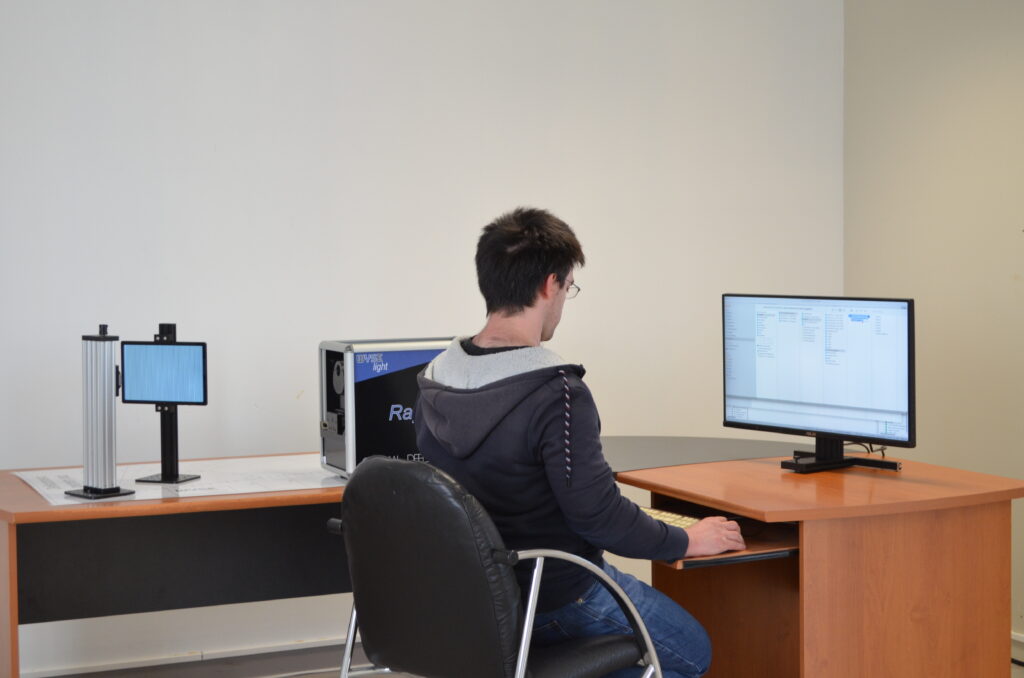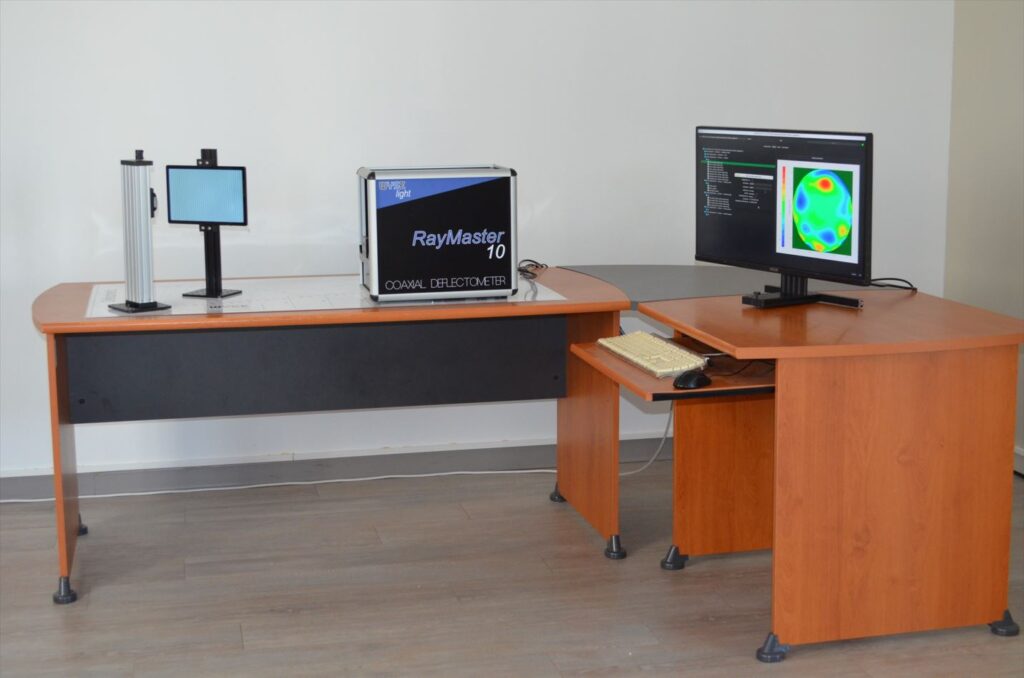This is the first model or our range. Others will come soon…
Raymaster 10
The raymaster 10 is designed to perform 3D surface shape measurements with interferometry-like accuracy. Deflectometry allows full field single shot measurements. Our product is capable of measuring a large variety of surfaces from flat to freeform optics. Its compact dimensions and insensitivity to vibrations make it usable on a regular desk.

The shape of a surface is supposed to be described as a function z(x,y). When measuring a part, our system provides a cloud of points z(x(i,j), y(i,j)), where x(i,j) and y(i,j) are points of a regularly spaced Cartesian grid indexed by i and j.
If the nominal (equation) shape is provided, the system also provides the optimal deviation ∆z(x(i,j), y(i,j)) between the measured and nominal shapes. So it is not the distance along the surface normal, but the altitude (z) deviation along the z axis. The x,y plane is chosen to be tangent to the part in the vicinity of its center. The nominal shape is shifted/tilted/rotated with respect to the measured shape so that ∆z is minimized.
Main features
- Suitable for reflective surfaces (flat, concave, convex, asphere, freeform).
- Insensitive to vibrations.
- Non-contact.
- One single shot measurement, fast measurement (minutes).
- Easy to use, push button device.
- Typical uncertainty of 15 nm RMS. The 15 nm we refer to is the mean RMS we observe between our measurements and others made with alternative systems (Zygo, Luphoscan or Nanomefos), it is rather an empirical value not resulting of a strict uncertainty evaluation.
| Specifications | |
| Accuracy (RMS), mid and high spatial frequencies | 15 nm |
| Repeatability (RMS) | 5 nm |
| Relative accuracy, low spatial frequency (radius of curvature) | 0.1 % |
| Spatial resolution (600 mm working distance) | 50 µm |
| Modes of operation | a) Blind (no knowledge of nominal shape) b) Smart (deviation to nominal shape) |
| Optical axis orientation | Horizontal |
| Optical axis height | 280 mm |

Configuration supplied:
- 9 inches tablet (to display fringes used during the measurement process) and its pole mount;
- pole mount for the object to be measured (vertical profile support);
- RayMaster 10 measurement unit (contains the camera and the processing unit);
- software for acquisition, calculations, display of results (developed by Wyse Light);
- accessories to facilitate components positionning;
- 28 inches display monitor, keyboard, mouse.
Requirements
- Power : 100 to 240 VAC, 50/60 Hz
Hardware specifications
- Storage : SSD drive of 256 GB
- Communications : 1 Gb RJ-45 Ethernet, wifi 6E (802.11ax), Bluetooth 5.3, 2 ports USB-A, 2 ports Thunderbolt 4
- Measurement unit : 400x400x242mm. 6,35 kg
- Full configuration gross weight : 28 kg (comprising measurement unit, all accessories, displays and packaging)
- Package dimensions : 800 x 600 x 440 mm
Warranty
- 1 year – express return + free chat and whatsapp hotline + software updates
The system is designed and manufactured by Wyse Light, and assembled in France by Wyse Light.
Simple setup and operation
Setting up the full configuration after unboxing requires no more than 30 minutes. It operates on a standard office desk. No need for an optical bench.
Performing measurements requires prior identification steps that are carried out initially in our facility. It is recommended to run those identification steps from time to time on site to prevent precision deviation which can occur after brutal handling, or significant repeated temperature variations in the lab. The process is simple and mainly automated. All in all, it takes about 30 minutes.
Measurement is very simple too. It consists in two steps :
- tablet identification : the images displayed on the tablet during measurement must reflect on the part to be measured. To maximize accuracy, the tablet should be placed at an optimal distance and angle from the part so that the images fully reflect on the part. Then the system records the position of the tablet. The process is simple and takes only 1mn with minimal handling. You can make as many measurement as you wish afterwards. Only if you move the tablet/screen, you need to make a tablet/screen indentification again.
- part measurement : once the system has recorded the tablet position (tablet identification step above), the measurement can take place. The measurement process is automatic. The camera inside the Raymaster 10 moves automatically to acquire different pictures of the object, at different distance. The images are then processed by the calculator and the result is displayed on the screen with information relative to the precision of the measurement. Again, this a a full field single shot. No image stitching needed as long as the size of the tablet fits the size and shape of the part. If the part is too large, the standard tablet can be replaced by a lerger one or a display monitor with adequate specifications.